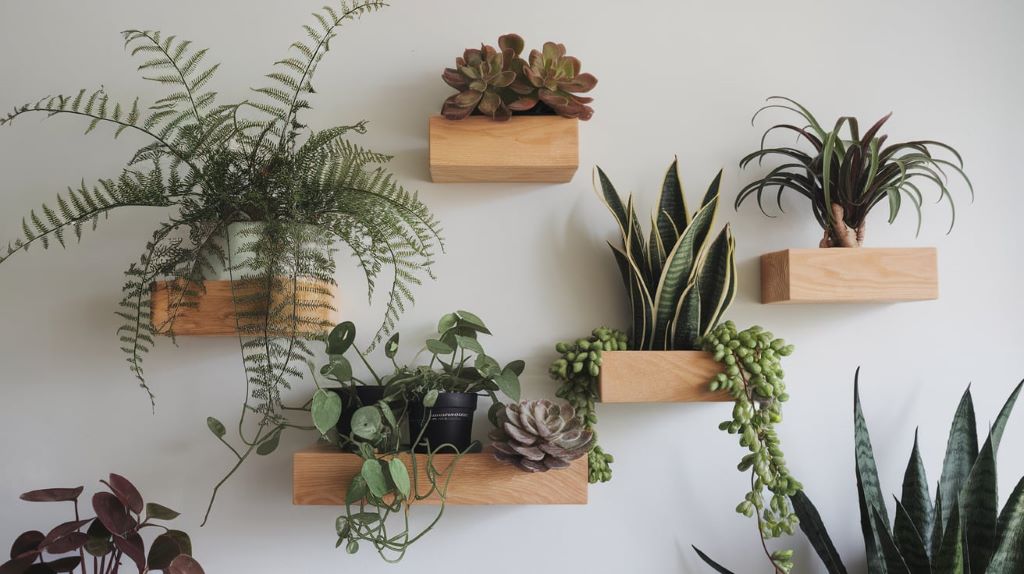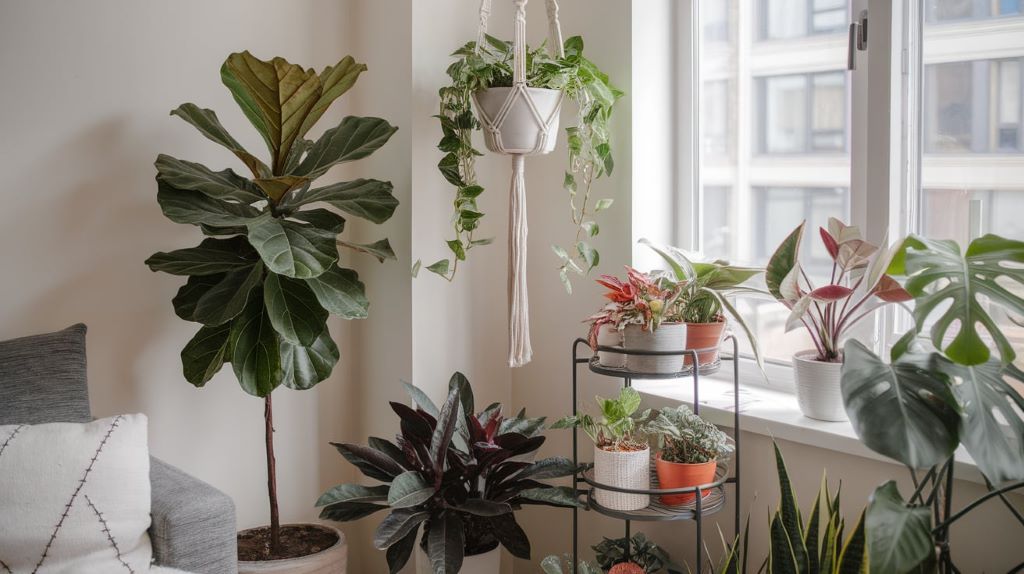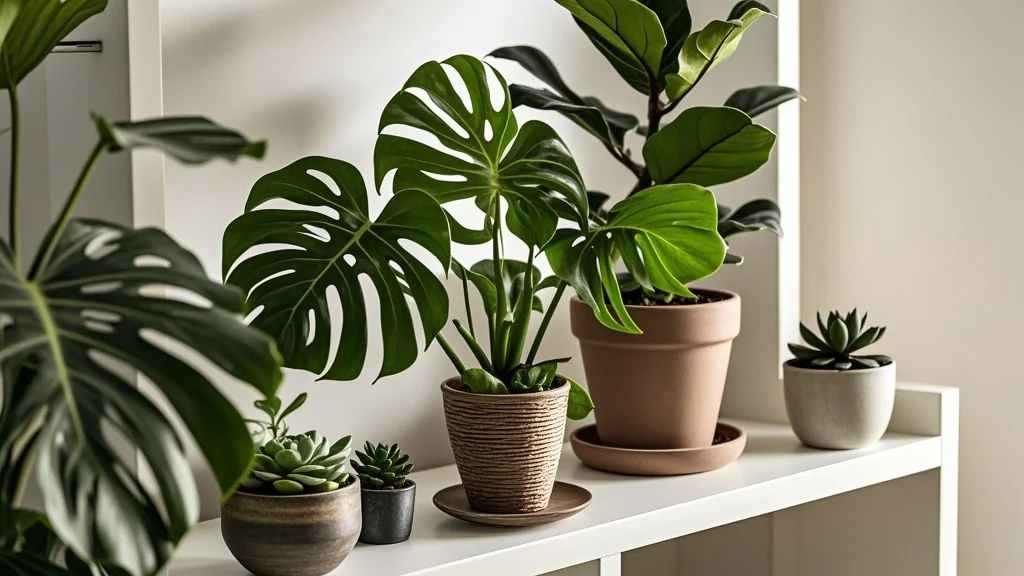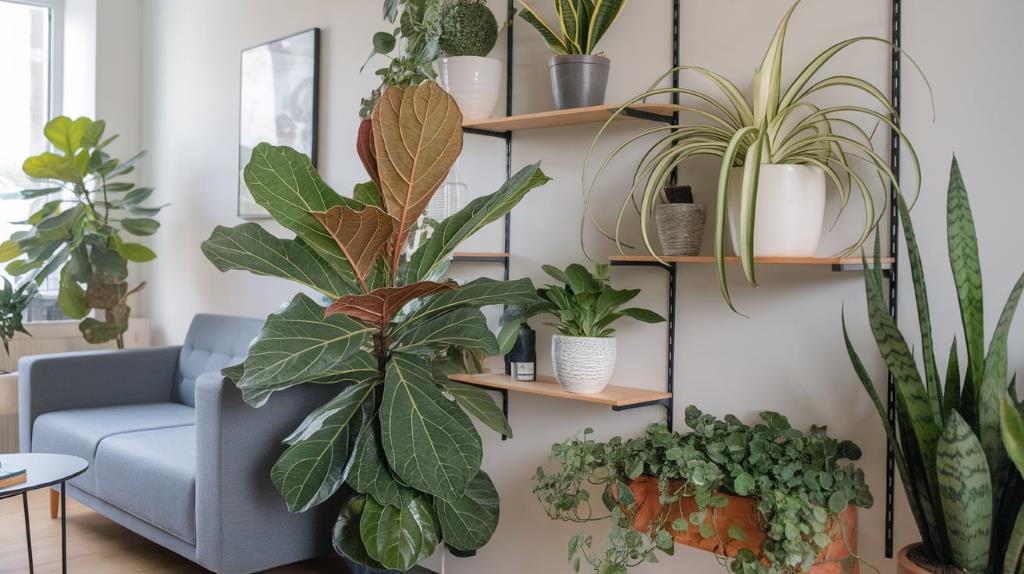Living in a small apartment doesn’t mean sacrificing your dream of creating an indoor garden oasis. With thoughtful planning and strategic placement, even the most compact spaces can be transformed into lush, green sanctuaries. The key lies in understanding how to arrange your plants to maximize both aesthetic appeal and growing conditions while minimizing clutter. This guide will walk you through practical strategies for creating a harmonious plant layout that works with—not against—your limited square footage.
Contents
Assessing Your Space
Light Mapping
Before purchasing a single plant, take time to understand the light conditions in your apartment:
- Track sunlight patterns throughout the day in different areas
- Identify light zones: direct sun (south-facing windows), bright indirect (east/west windows), and low light (north windows or interior spaces)
- Note seasonal changes in light intensity and duration
- Document with photos at different times to reference when selecting plants
Creating a simple light map of your apartment will serve as the foundation for all your plant arrangement decisions, ensuring each green friend receives appropriate light conditions.
Space Inventory
Next, catalog potential plant placement areas:
- Window sills and ledges
- Floor space near windows
- Wall space for hanging or mounted options
- Furniture surfaces like tables, shelves, and cabinets
- Ceiling areas for hanging plants
- Unused corners that could accommodate vertical arrangements
Measure each potential area and note any constraints like heating vents, air conditioners, or high-traffic zones that might impact plant health or placement.
Vertical Thinking: Maximizing Height

Small apartments demand thinking beyond floor space. The vertical dimension offers abundant opportunities for plant displays without sacrificing precious square footage.
Wall-Mounted Solutions
- Floating shelves installed at varying heights create dynamic plant displays
- Wall planters and pocket gardens bring greenery to eye level
- Mounted plant brackets allow for adjustable positioning near windows
- Picture frame planters combine art and plants in one space-saving display
- Pegboard systems offer flexible arrangements that can evolve with your collection
Hanging Displays
- Macramé plant hangers add bohemian charm while drawing the eye upward
- Ceiling hooks with adjustable chains allow for height customization
- Tension rod systems between walls create plant “curtains” without permanent installation
- Hanging terrariums showcase miniature landscapes at eye level
- Suspended plant shelves on rope or chain systems maximize corner spaces
Vertical Gardens
- Modular wall systems with integrated irrigation for serious plant enthusiasts
- Repurposed shoe organizers create pocket gardens for herbs and small plants
- Ladder shelves provide graduated display space with a small footprint
- Tiered plant stands maximize vertical space near windows
- Stacked crates or boxes create customizable vertical gardens
Strategic Grouping Techniques
How you arrange plants in relation to each other can dramatically impact both their health and visual appeal in small spaces.
Clustering by Care Needs
Group plants with similar requirements to:
- Simplify watering routines
- Create microclimates that benefit multiple plants
- Make maintenance more efficient
Consider these natural groupings:
- Humidity lovers: ferns, calatheas, and peace lilies
- Drought-tolerant plants: succulents, cacti, and ZZ plants
- Bright light enthusiasts: most flowering plants and variegated varieties
- Shade tolerators: snake plants, pothos, and many philodendrons
Visual Composition Principles
Even in small spaces, thoughtful arrangement creates visual impact:
- Create depth by placing taller plants behind shorter ones
- Vary textures by mixing feathery ferns with broad-leafed plants
- Consider color harmony through complementary leaf colors and patterns
- Establish rhythm with repeated plant forms at different heights
- Create focal points with statement plants or distinctive containers
Space-Defining Arrangements
Strategic plant placement can actually make your apartment feel larger:
- Room dividers: Tall plants on stands create natural separation between living areas
- Corner emphasis: Filling empty corners draws the eye outward, expanding perceived space
- Ceiling connection: Hanging plants in clusters creates vertical interest that makes ceilings feel higher
- Depth creation: Layered plant arrangements add dimension to flat walls
Multi-Functional Furniture Integration
In small apartments, furniture that serves multiple purposes is essential. Incorporating plants into these elements maximizes space efficiency.
Built-In Plant Displays
- Bookshelf integration: Alternate books with plants for a curated look
- Entertainment center styling: Frame TV or media equipment with cascading plants
- Desk gardens: Incorporate small plants into your workspace for productivity benefits
- Kitchen herb stations: Utilize countertop edges for practical and beautiful herb displays
- Bathroom plant zones: Leverage humidity with shower-adjacent plant shelving
Furniture as Plant Support
- Sofa tables behind couches create prime real estate for medium-sized plants
- Plant stands that double as side tables provide both display and function
- Coffee tables with built-in planters bring greenery to central living spaces
- Room dividers with integrated shelving for plants create privacy and beauty
- Headboard alternatives using tall plants frame beds while purifying bedroom air
Hidden Spaces
Don’t overlook these often-forgotten plant placement opportunities:
- Above kitchen cabinets for trailing plants that thrive in indirect light
- Behind furniture where slim plants can add depth without taking up usable space
- Under stairs in duplex apartments or lofts
- Inside rarely-used fireplaces as seasonal plant displays
- Windowsill extensions that expand your growing area without permanent installation
Container Strategies for Small Spaces
Your choice of planters significantly impacts both the health of your plants and the visual cohesion of your space.
Size Considerations
- Right-size your containers to prevent plants from becoming root-bound too quickly
- Consider mature plant size when selecting pots to minimize repotting frequency
- Use shallow containers for plants with surface root systems to save vertical space
- Select narrow planters for windowsills and tight spaces
- Choose lightweight materials for hanging or wall-mounted displays
Visual Cohesion Techniques
Create a unified look with these container strategies:
- Color coordination: Select a limited palette that complements your décor
- Material consistency: Stick with primarily ceramic, terracotta, or basket planters
- Style grouping: Maintain similar design aesthetics (modern, bohemian, minimalist)
- Size progression: Use graduated pot sizes within groupings for visual flow
- Matching saucers or drip trays: Create a finished look while protecting surfaces
Space-Saving Container Options
- Wall pocket planters that flatten on one side for flush mounting
- Magnetic planters for metal surfaces like refrigerators
- Stackable planters that build vertically with integrated drainage
- Railing planters for balconies and stair railings
- Corner-shaped containers designed specifically for awkward spaces
Specialized Small-Space Plant Displays
Some innovative display methods are particularly well-suited to apartment living.
Terrariums and Miniature Gardens
- Closed terrariums create self-sustaining ecosystems requiring minimal care
- Open dish gardens showcase miniature plant arrangements in limited space
- Bottle gardens recycle glass containers into unique growing environments
- Kokedama (Japanese moss balls) eliminate pots entirely for space efficiency
- Fairy gardens create whimsical miniature landscapes with tiny accessories
Window Optimization
Windows are prime real estate in small apartments:
- Tension rod plant shelves create adjustable growing space within window frames
- Suction cup planters attach directly to glass for unobstructed views
- Window box extensions expand growing space outward
- Glass shelves installed within window frames maximize light exposure
- Prism planters hang in windows, creating rainbow effects while growing plants
Mobile Plant Displays
Flexibility is key in small spaces:
- Plant carts on wheels allow for easy repositioning based on light or social needs
- Hanging systems on tracks enable plants to move along ceiling paths
- Nesting plant stands that expand or contract based on available space
- Folding plant walls that can be collapsed when not in display mode
- Modular planting systems that reconfigure as your collection or needs change
Seasonal Rotation Strategies
Small spaces benefit from dynamic arrangements that evolve throughout the year.
Light Adaptation
- Summer adjustments: Move plants away from intensely hot windows
- Winter repositioning: Cluster light-loving plants near brightest windows
- Grow light supplementation: Add artificial lighting during darker months
- Rotation schedule: Move plants quarterly to ensure even growth
- Light reflection: Use mirrors strategically to bounce light to plants in darker corners
Growth Cycle Management
- Rest period planning: Move dormant plants to less prominent positions
- Flowering showcase: Feature blooming plants in high-visibility areas when in season
- Propagation station: Dedicate a small area to nurturing cuttings and seedlings
- Rehabilitation corner: Create a special care area for plants needing extra attention
- Seasonal pruning: Maintain appropriate plant size through regular trimming
Display Refreshment
Keep your space feeling fresh with these rotation ideas:
- Monthly focal point: Highlight different statement plants throughout the year
- Seasonal color themes: Emphasize plants with seasonal color variations
- Holiday arrangements: Create temporary displays for special occasions
- New acquisition showcase: Feature new plants prominently before integrating them
- Photography documentation: Track your arrangements to repeat successful combinations
Practical Maintenance Considerations
Beautiful arrangements must also be practical for long-term success in small spaces.
Watering Logistics
- Group plants by watering needs to streamline maintenance
- Install drip trays or saucers to protect surfaces from water damage
- Consider self-watering planters for vacation periods
- Create watering stations near sinks for easy plant rotation
- Use moisture meters to prevent overwatering in closely packed arrangements
Pest Management
Pests spread quickly in dense plant arrangements:
- Maintain adequate spacing for air circulation between plants
- Establish quarantine areas for new plants before introducing them
- Conduct weekly inspections of leaf undersides and soil surfaces
- Keep natural pest control solutions readily accessible
- Rotate plants during cleaning to inspect hidden areas
Growth Management
Prevent your urban jungle from overtaking your living space:
- Regular pruning schedule to maintain appropriate size
- Strategic pinching to encourage bushier growth rather than height
- Root pruning during repotting to control size
- Selection of dwarf varieties when available
- Growth direction training using stakes and supports
Conclusion

Arranging plants in a small apartment is both an art and a science. By thinking vertically, grouping strategically, integrating with furniture, and maintaining flexibility, you can create a thriving indoor garden that enhances rather than overwhelms your space. Remember that plant arrangements should evolve as both your collection and your understanding grow. With these strategies, your small apartment can become a verdant retreat that feels more spacious, more alive, and more uniquely yours.
The most successful small-space plant parents approach their arrangements with creativity, patience, and a willingness to experiment. Start with a few key plants in well-considered locations, then gradually expand your collection as you discover what thrives in your particular environment. Your apartment may be small, but your gardening ambitions don’t have to be!









